Also available:
The Beer Token [Video]
This post is also available as an article. So if you'd rather read a conventional blog post of this content, you can!
This post is also available as an article. So if you'd rather read a conventional blog post of this content, you can!
This post is also available as a podcast. Listen here, download for later, or subscribe wherever you consume podcasts.
This post is also available as a video. If you'd prefer to watch/listen to me talk about this topic, give it a look.
The novelisation of The Hitch-Hiker’s Guide to the Galaxy came out in 1979, just a smidge before I was born. There’s a well-known scene in the second chapter featuring Ford Prefect, an alien living on Earth, distracting his human friend Arthur Dent. Arthur is concerned about the imminent demolition of his house by a wrecking crew, and Ford takes him to the pub to get him drunk, in anticipation of the pair attempting to hitch a lift on an orbiting spacecraft that’s about to destroy the planet:
“Six pints of bitter,” said Ford Prefect to the barman of the Horse and Groom. “And quickly please, the world’s about to end.”
The barman of the Horse and Groom didn’t deserve this sort of treatment, he was a dignified old man. He pushed his glasses up his nose and blinked at Ford Prefect. Ford ignored him and stared out of the window, so the barman looked instead at Arthur who shrugged helplessly and said nothing.
So the barman said, “Oh yes sir? Nice weather for it,” and started pulling pints.
He tried again.
“Going to watch the match this afternoon then?”
Ford glanced round at him.
“No, no point,” he said, and looked back out of the window.
“What’s that, foregone conclusion then you reckon sir?” said the barman. “Arsenal without a chance?”
“No, no,” said Ford, “it’s just that the world’s about to end.”
“Oh yes sir, so you said,” said the barman, looking over his glasses this time at Arthur. “Lucky escape for Arsenal if it did.”
Ford looked back at him, genuinely surprised.
“No, not really,” he said. He frowned.
The barman breathed in heavily. “There you are sir, six pints,” he said.
Arthur smiled at him wanly and shrugged again. He turned and smiled wanly at the rest of the pub just in case any of them had heard what was going on.
None of them had, and none of them could understand what he was smiling at them for.
A man sitting next to Ford at the bar looked at the two men, looked at the six pints, did a swift burst of mental arithmetic, arrived at an answer he liked and grinned a stupid hopeful grin at them.
“Get off,” said Ford, “They’re ours,” giving him a look that would have an Algolian Suntiger get on with what it was doing.
Ford slapped a five-pound note on the bar. He said, “Keep the change.”
“What, from a fiver? Thank you sir.”
There’s a few great jokes there, but I’m interested in the final line. Ford buys six pints of bitter, pays with a five-pound note, and says “keep the change”, which surprises the barman. Presumably this is as a result of Ford’s perceived generosity… though of course what’s really happening is that Ford has no use for Earth money any longer; this point is hammered home for the barman and nearby patrons when Ford later buys four packets of peanuts, also asking the barman to keep the change from a fiver.

We’re never told exactly what the barman would have charged Ford. But looking at the history of average UK beer prices and assuming that the story is set in 1979, we can assume that the pints will have been around 34p each1, so around £2.04 for six of them. So… Ford left a 194% tip for the beer2.
By the time I first read Hitch-Hikers, around 1990, this joke was already dated. By then, an average pint of bitter would set you back £1.10. I didn’t have a good awareness of that, being as I was well-underage to be buying myself alcohol! But I clearly had enough of an awareness that my dad took the time to explain the joke… that is, to point out that when the story was written (and is presumably set), six pints would cost less than half of five pounds.
But by the mid-nineties, when I’d found a friend group who were also familiar with the Hitch-Hikers… series, we’d joke about it. Like pointing out that by then if you told the barman to keep the change from £5 after buying six pints, the reason he’d express surprise wouldn’t be because you’d overpaid…
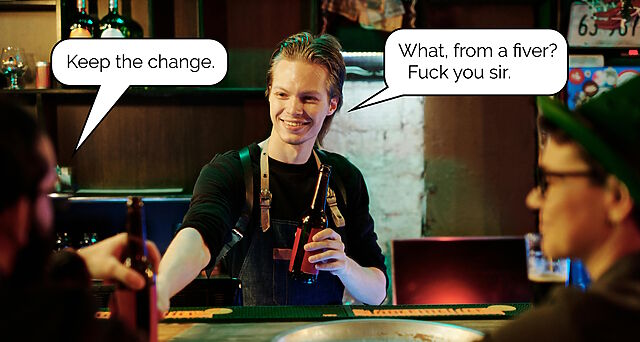
Precocious drinker that I was, by the late nineties I was quite aware of the (financial) cost of drinking.

And so when it was announced that a new denomination of coin – the £2 coin – would enter general circulation3 I was pleased to announce how sporting it was of the government to release a “beer token”.
With the average pint of beer at the time costing around £1.90 and a still cash-dominated economy, the “beer token” was perfect! And in my case, it lasted: the bars I was drinking at in the late 1990s were in the impoverished North, and were soon replaced with studenty bars on the West coast of Wales, both of which allowed the price of a pint to do battle with inflationary forces for longer than might have been expected elsewhere in the country. The “beer token” that was the £2 coin was a joke that kept on giving for some time.

As the cost of living rapidly increased circa 2023, the average price of a pint of beer in the UK finally got to the point where, rounded to the nearest whole pound, it was closer to £5 than it is to £44.
And while we could moan and complain about how much things cost nowadays, I’d prefer to see this as an opportunity. An opportunity for a new beer token: a general-release of the £5 coin. We already some defined characteristics that fit: a large, heavy coin, about twice the weight of the £2 coin, with a copper/nickel lustre and struck from engravings with thick, clear lines.
And the design basically comes up with itself. I give you… the Beer Token of the 2020s:

It’s time for the beer token to return, in the form of the £5 coin. Now is the time… now is the last time, probably… before cash becomes such a rarity that little thought is evermore given to the intersection of its design and utility. And compared to a coin that celebrates industry while simultaneously representing a disfunctional machine, this is a coin that Brits could actually be proud of. It’s a coin that tourists would love to take home with them, creating a satisfying new level of demand for the sinking British Pound that might, just might, prop up the economy a little, just as here at home they support those who prop up the bar.
I know there must be a politician out there who’s ready to stand up and call for this new coin. My only fear is that it’s Nigel Fucking Farage… at which point I’d be morally compelled to reject my own proposal.
But for now, I think I’ll have another drink.
1 The recession of the 1970s brought high inflation that caused the price of beer to rocket, pretty much tripling in price over the course of the decade. Probably Douglas Adams didn’t anticipate that it’d more-than-double again over the course of the 1980s before finally slowing down somewhat… at least until tax changes in 2003 and the aftermath of the 2022 inflation rate spike!
2 We do know that the four packets of peanuts Ford bought later were priced at 7p each, so his tip on that transaction was a massive 1,686%: little wonder the barman suddenly started taking more-seriously Ford’s claims about the imminent end of the world!
3 There were commemorative £2 coins of a monometallic design floating around already, of course, but – being collectible – these weren’t usually found in circulation, so I’m ignoring them.
4 Otherwise known as “two beer tokens”, of course. As in “Bloody hell, 2022, why does a pint of draught cost two beer tokens now?”
This week, AI firm Anthropic (the folks behind Claude) found themselves the focus of attention of U.S. District Court for the Northern District of California.
The tl;dr is: the court ruled that (a) piracy for the purpose of training an LLM is still piracy, so there’ll be a separate case about the fact that Anthropic did not pay for copies of all the books their model ingested, but (b) training a model on books and then selling access to that model, which can then produce output based on what it has “learned” from those books, is considered transformative work and therefore fair use.
Compelling arguments have been made both ways on this topic already, e.g.:
Here’s a thought experiment:
Support I trained an LLM on all of the books of just one author (plus enough additional language that it was able to meaningfully communicate). Let’s take Stephen King’s 65 novels and 200+ short stories, for example. We’ll sell access to the API we produce.

The output of this system would be heavily-biased by the limited input it’s been given: anybody familiar with King’s work would quickly spot that the AI’s mannerisms echoed his writing style. Appropriately prompted – or just by chance – such a system would likely produce whole chapters of output that would certainly be considered to be a substantial infringement of the original work, right?
If I make KingLLM, I’m going to get sued, rightly enough.
But if we accept that (and assume that the U.S. District Court for the Northern District of California would agree)… then this ruling on Anthropic would carry a curious implication. That if enough content is ingested, the operation of the LLM in itself is no longer copyright infringement.
Which raises the question: where is the line? What size of corpus must a system be trained upon before its processing must necessarily be considered transformative of its inputs?
Clearly, trying to answer that question leads to a variant of the sorites paradox. Nobody can ever say that, for example, an input of twenty million words is enough to make a model transformative but just one fewer and it must be considered to be perpetually ripping off what little knowledge it has!
But as more of these copyright holder vs. AI company cases come to fruition, it’ll be interesting to see where courts fall. What is fair use and what is infringing?
And wherever the answers land, I’m sure there’ll be folks like me coming up with thought experiments that sit uncomfortably in the grey areas that remain.
 What can I possibly say about Bored Gay Werewolf, which caught my attention
with the garish colours of its front cover when I saw it in Waterstones and whose blurb suggested that it might, perhaps, be a queer fantasy romp with a Buffy-esque sense of
humour.
What can I possibly say about Bored Gay Werewolf, which caught my attention
with the garish colours of its front cover when I saw it in Waterstones and whose blurb suggested that it might, perhaps, be a queer fantasy romp with a Buffy-esque sense of
humour.
Werewolf? Sure, it’s got a few of those. There’s even a bit of fun, offbeat humour each time the protagonist reflects on their curious monthly cycle and tries to work out whether they attacked or even killed anybody this time around. But mostly it’s not a story about werewolf: it’s a story about a slacker who gets suckered into a pyramid scheme, with just a hint of lycanthropy around the fringes.
Gay? I mean: the protagonist’s gay, and many of their friends are queer… and while the representation is good, sexuality doesn’t feel like it’s a particularly significant issue to the storyline. I enjoyed the parallels that were drawn between Brian’s coming-out as gay versus his (for most of the story) closeted werewolf nature – which even though I saw them coming from the first chapter onwards were still well-presented – but apart from that it almost felt like gayness wasn’t a central theme to the story. A smidge of homophobia, some queer culture references, and a throwaway Grindr hookup with a closeted MSM dude do not contribute enough homosexuality to justify “gay” being the largest, pinkest word on a novel’s cover, if you ask me.
Bored? I was, at some points in the book, but I’m not convinced that’s what was intended. The pacing’s a little inconsistent: a long and drawn-out description of an exercise routines overshadows an exploration of the impact of werewolf super-senses, for example. And a long-foreshadowed fight scene finale feels like it’s over in an instant (with a Van Helsing ex Machina twist that felt simultaneously like the brakes being slammed on and a set-up for an inevitable sequel).
I sound pretty negative about it, I’m sure. But it’s not actually bad. It’s just not actually good, either. It’s a passable, middle-of-the-road time-filler with an interesting hook, a few funny set pieces (I laughed out loud a couple of times, for sure), and a set of misfit characters who spend most of the book feeling a little… incomplete? Though it’s possible that latter point’s at-least partially deliberate, as this is without a doubt a “Gen-Z Grows Up” story. Maybe if I were younger and didn’t yet have my shit together the story would appeal better.
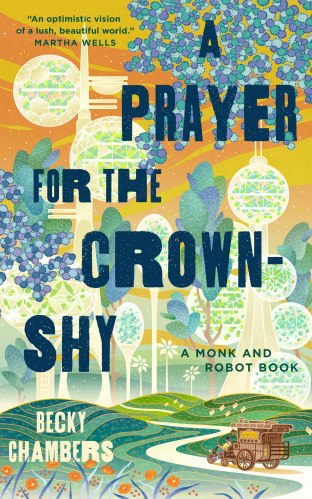 As soon as I finished reading its prequel, I started reading Becky Chambers’ A
Prayer for the Crown-Shy (and then, for various work/life reasons, only got around to publishing my micro-review just now).
As soon as I finished reading its prequel, I started reading Becky Chambers’ A
Prayer for the Crown-Shy (and then, for various work/life reasons, only got around to publishing my micro-review just now).
The book carries on directly from where A Psalm for the Wild-Built left off, to such a degree that at first I wondered whether the pair might have been better published as a single volume. But in hindsight, I appreciate the separation: there’s a thematic shift between the two that benefits from a little (literal) bookending.
Both Wild-Built and Crown-Shy look at the idea of individual purpose and identity, primarily through the vehicle of relatable protagonist Sibling Dex as they very-openly seek their place in the world, and to a lesser extent through the curiosity and inquisitiveness of the robot Mosscap.
But the biggest difference in my mind between the ways in which the two do so is the source of the locus of evaluation: the vast majority of Wild-Built is experienced only by Dex and Mosscap, alone together in the wilderness at the frontier between their disparate worlds. It maintains an internal locus of evaluation, with Dex asking questions of themselves about why they feel unfulfilled and Mosscap acting as a questioning foil and supportive friend. Crown-Shy, by contrast, pivots to a perceived external locus of evaluation: Dex and Mosscap return from the wilderness to civilisation, and both need to adapt to the experience of celebrity, questioning, and – in Mosscap’s case – a world completely-unfamiliar to it.
By looking more-carefully at Dex’s society, the book helps to remind us about the diverse nature of humankind. For example: we’re shown that even in a utopia, individual people will disagree on issues and have different philosophical outlooks… but the underlying message is that we can still be respectful and kind to one another, despite our disagreement. In the fourth chapter, the duo visit a coastland settlement whose residents choose to live a life, for the most part, without the convenience of electricity. By way of deference to their traditions, Dex (with their electric bike) and Mosscap (being an electronic entity) wait outside the village until invited in by one of the residents, and the trio enjoy a considerate discussion about the different value systems of people around the continent while casting fishing lines off a jetty. There’s no blame; no coercion; and while it’s implied that other residents of the village are staying well clear of the visitors, nothing more than this exclusion and being-separate is apparent. There’s sort-of a mutual assumption that people will agree-to-disagree and get along within the scope of their shared vision.
Which leads to the nub of the matter: while it appears that we’re seeing how Dex is viewed by others – by those they disagree with, by those who hold them with some kind of celebrity status, by their family with whom they – like many folks do – share a loving but not uncomplicated relationship – we’re actually still experiencing this internally. The questions on Dex’s mind remain “who am I?”, “what is my purpose?”, and “what do I want?”… questions only they can answer… but now they’re considering them from the context of their relationship with everybody else in their world, instead of their relationship with themself.
Everything I just wrote reads as very-pretentious, for which I apologise. The book’s much better-written than my review! Let me share a favourite passage, from a part of the book where Dex is introducing Mosscap to ‘pebs’, a sort-of currency used by their people, by way of explanation as to why people whom Mosscap had helped had given it pieces of paper with numbers written on (Mosscap not yet owning a computer capable of tracking its balance). I particularly love Mosscap’s excitement at the possibility that it might own things, an experience it previous had no need for:
…
Mosscap smoothed the crease in the paper, as though it were touching something rare and precious. “I know I’m going to get a computer, but can I keep this as well?”
“Yeah,” Dex said with a smile. “Of course you can.”
“A map, a note, and a pocket computer,” Mosscap said reverently. “That’s three belongings.” It laughed. “I’ll need my own wagon, at this rate.”
“Okay, please don’t get that much stuff,” Dex said. “But we can get you a satchel or something, if you want, so you don’t have things rattling around inside you.”
Mosscap stopped laughing, and looked at Dex with the utmost seriousness. “Could I really?” it said quietly. “Could I have a satchel?”
…
That’s just a heartwarming and childlike response to being told that you’re allowed to own property of your very own. And that’s the kind of comforting joy that, like its prequel, the entire book exudes.
A Prayer for the Crown-Shy is not quite so wondrous as A Psalm for the Wild-Built. How could it be, when we’re no longer quite so-surprised by the enthralling world in which it’s set. But it’s still absolutely magnificent, and I can wholeheartedly recommend the pair.
This post is also available as a podcast. Listen here, download for later, or subscribe wherever you consume podcasts.
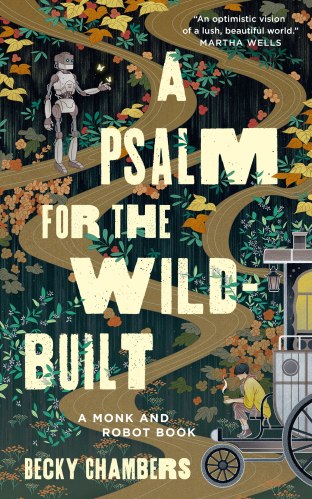 I’d already read every prior book published by the excellent Becky Chambers, but this (and its sequel) had been sitting on my to-read list for some time,
and so while I’ve been ill and off work these last few days, I felt it would be a perfect opportunity to
pick it up. I’ve spent most of this week so far in bed, often drifting in and out of sleep, and a lightweight novella that I coud dip in and out of over the course of a day felt like
the ideal comfort.
I’d already read every prior book published by the excellent Becky Chambers, but this (and its sequel) had been sitting on my to-read list for some time,
and so while I’ve been ill and off work these last few days, I felt it would be a perfect opportunity to
pick it up. I’ve spent most of this week so far in bed, often drifting in and out of sleep, and a lightweight novella that I coud dip in and out of over the course of a day felt like
the ideal comfort.
I couldn’t have been more right, as the very first page gave away. My friend Ash described the experience of reading it (and its sequel) as being “like sitting in a warm bath”, and I see where they’re coming from. True to form, Chambers does a magnificent job of spinning a believable utopia: a world that acts like an idealised future while still being familiar enough for the reader to easily engage with it. The world of Wild-Built is inhabited by humans whose past saw them come together to prevent catastrophic climate change and peacefully move beyond their creation of general-purpose AI, eventually building for themselves a post-scarcity economy based on caring communities living in harmony with their ecosystem.
Writing a story in a utopia has sometimes been seen as challenging, because without anything to strive for, what is there for a protagonist to strive against? But Wild-Built has no such problem. Written throughout with a close personal focus on Sibling Dex, a city monk who decides to uproot their life to travel around the various agrarian lands of their world, a growing philosophical theme emerges: once ones needs have been met, how does one identify with ones purpose? Deprived of the struggle to climb some Maslowian pyramid, how does a person freed of their immediate needs (unless they choose to take unnecessary risks: we hear of hikers who die exploring the uncultivated wilderness Dex’s people leave to nature, for example) define their place in the world?
Aside from Dex, the other major character in the book is Mosscap, a robot whom they meet by a chance encounter on the very edge of human civilisation. Nobody has seen a robot for centuries, since such machines became self-aware and, rather than consign them to slavery, the humans set them free (at which point they vanished to go do their own thing).
To take a diversion from the plot, can I just share for a moment a few lines from an early conversation between Dex and Mosscap, in which I think the level of mutual interpersonal respect shown by the characters mirrors the utopia of the author’s construction:
…
“What—what are you? What is this? Why are you here?”
The robot, again, looked confused. “Do you not know? Do you no longer speak of us?”
“We—I mean, we tell stories about—is robots the right word? Do you call yourself robots or something else?”
“Robot is correct.”
…
“Okay. Mosscap. I’m Dex. Do you have a gender?”
“No.”
“Me neither.”
These two strangers take the time in their initial introduction to ensure they’re using the right terms for one another: starting with those relating to their… let’s say species… and then working towards pronouns (Dex uses they/them, which seems to be widespread and commonplace but far from universal in their society; Mosscap uses it/its, which provides for an entire discussion on the nature of objectship and objectification in self-identity). It’s queer as anything, and a delightful touch.
In any case: the outward presence of the plot revolves around a question that the robot has been charged to find an answer to: “What do humans need?” The narrative theme of self-defined purpose and desires is both a presenting and a subtextual issue, and it carries through every chapter. The entire book is as much a thought experiment as it is a novel, but it doesn’t diminish in the slightest from the delightful adventure that carries it.
Dex and Mosscap go on to explore the world, to learn more about it and about one another, and crucially about themselves and their place in it. It’s charming and wonderful and uplifting and, I suppose, like a warm bath: comfortable and calming and centering. And it does an excellent job of setting the stage for the second book in the series, which we’ll get to presently…
Third day of being ill with what’s probably a winter vomiting bug, with one child home sick from school… and just having had to collect the other kid who started throwing up on his school trip… I finally got back to my bed and picked up the next book on my pile, Becky Chambers’ A Psalm for the Willd-Built.
The opening page reads: “For anybody who could use a break.”
Yes. Yes, please.
Ruth bought me a copy of The Adventure Challenge: Couples Edition, which is… well, it’s basically a book of 50 curious and unusual ideas for date activities. This week, for the first time, we gave it a go.
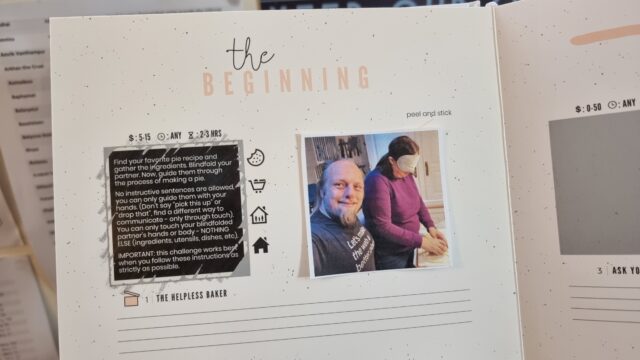
As a result, we spent this date night… baking a pie!
The book is written by Americans, but that wasn’t going to stop us from making a savoury pie. Of course, “bake a pie” isn’t much of a challenge by itself, which is why the book stipulates that:
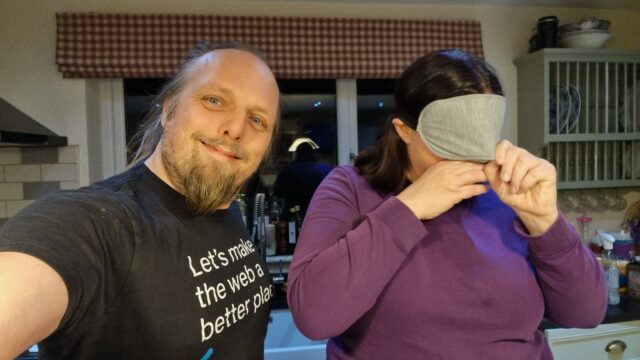
We used this recipe for “mini creamy mushroom pies”. We chose to interpret the brief as permitting pre-prep to be done in accordance with the ingredients list: e.g. because the ingredients list says “1 egg, beaten”, we were allowed to break and beat the egg first, before blindfolding up.
This was a smart choice (breaking an egg while blindfolded, even under close direction, would probably have been especially stress-inducing!).
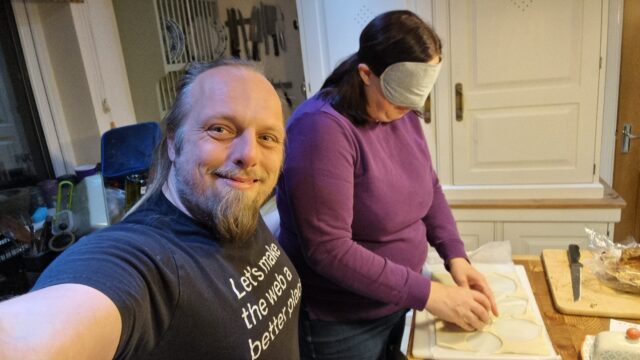
#JustSwitchThings
I really enjoyed this experience. It forced us into doing something different on date night (we have developed a bit of a pattern, as folks are wont to do), stretched our comfort zones, and left us with tasty tasty pies to each afterwards. That’s a win-win-win, in my book.
Plus, communication is sexy, and so anything that makes you practice your coupley-communication-skills is fundamentally hot and therefore a great date night activity.
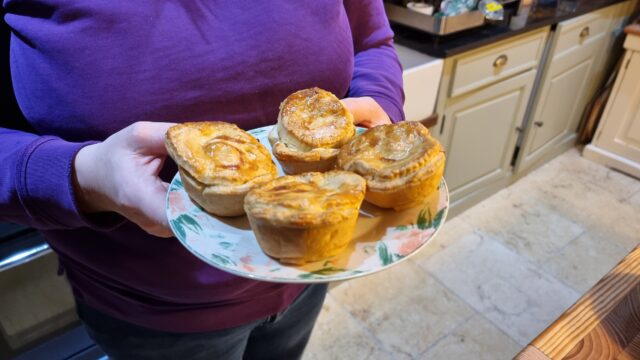
So yeah: we’ll probably be trying some of the other ideas in the book, when the time comes.
Some of the categories are pretty curious, and I’m already wondering what other couples we know that’d be brave enough to join us for the “double date” chapter: four challenges for which you need a second dyad to hang out with? (I’m, like… 90% sure it’s not going to be swinging. So if we know you and you’d like to volunteer yourselves, go ahead!)
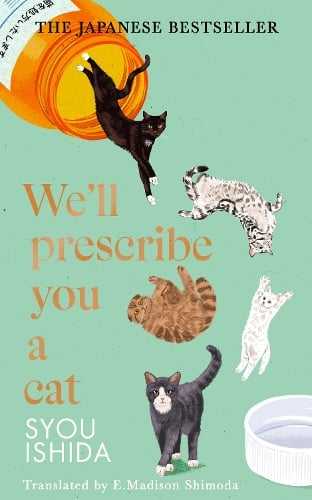 Another book I received at Christmas Eve’s book exchange
was We’ll Prescribe You A Cat by Syou
Ishida, translated from the original Japanese by Emmie Madison Shimoda. It’s apparently won all kinds of acclaim and awards and what-have-you, so I was hoping for something pretty
spectacular.
Another book I received at Christmas Eve’s book exchange
was We’ll Prescribe You A Cat by Syou
Ishida, translated from the original Japanese by Emmie Madison Shimoda. It’s apparently won all kinds of acclaim and awards and what-have-you, so I was hoping for something pretty
spectacular.
It’s… pretty good, I guess? Less a novel, it’s more like a collection of short stories with an overarching theme, within which a deeper plot which spans them all begins to emerge… but is never entirely resolved.
That repeating theme might be summed up as this: a person goes to visit a clinic – often under the illusion that it’s a psychiatric specialist – where, after briefly discussing their problems with the doctor, they’re prescribed a dose of “cat” for some number of days. There’s a surprising and fun humour in the prescription, each time: the matter-of-fact way that the doctor dispenses felines as if they were medications and resulting reactions of his nonplussed patients. Fundamentally, a prescription of cat works, and by the time the cat is returned to the clinic, its caretaker is cured, albeit not necessarily in the way in which they would have originally expected.
Standing alone, each chapter short story is excellent. The writing is compelling and rich and the characters well-developed, particularly in the short timeframes in which we
get to know each of them. There’s a lot of interesting bits of Japanese culture represented, too, which – as an outsider – piqued my curiosity: whether by the careful work of the author
or her translator it never left me feeling lost, although I suspect there might be a few subtler points I missed as a result of my geographic bias1.
The characters (whether human, feline, or… otherwise…?) and their situations are quirky and amusing, and there are a handful of heart-warming… and heart-wrenching… moments that I thoroughly enjoyed. But by the time I was half-way through the book, I was becoming invested in a payoff that would never come to be delivered. The nature of the doctor, his receptionist, and their somewhat-magical clinic is never really resolved, and the interconnections between the patients is close to non-existent, leaving the book feeling like a collection of tales that are related to… but not connected to… one another. As much as I’d enjoyed every story – and I did! – I nonetheless felt robbed of the opportunity to wrap up the theme that they belong to.
Instead, we’re given just more unanswered questions: hints at the nature of the clinic and its occupants, ideas that skirt around ideas of magic and ghosts, and no real explanation. Maybe the author’s planning to address it in the upcoming sequel, but unless I’m confident that’s the case, I’ll probably skip it.
In summary: some beautifully-written short stories with a common theme and a fun lens on Japanese culture, particularly likely to appeal to a cat lover, but with no payoff for getting invested in the overarching plot.
1 Ishida spends a significant amount of intention describing the regional accents of various secondary characters, and comparing those to the Kyoto dialect, for example. I’m pretty sure there’s more I could take from this if I had the cultural foothold to better understand the relevance! But most of the cultural differences are less-mysterious.